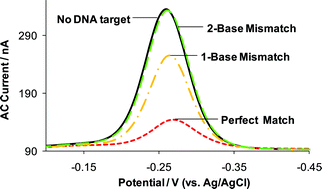Here we report the effect of passivating diluent chain length and sensor interrogation temperature on the electrochemical DNA (E-DNA) sensor's mismatch discrimination capability. Both stem-loop and linear probe-based E-DNA sensors were constructed with various diluents, including 6-mercapto-1-hexanol and longer chain hydroxyl-terminated alkanethiols. Contrary to previously reported results, we find that the E-DNA sensors work optimally in the presence of the longer chain diluents, signified by the enhanced % signal suppression observed upon target hybridization. Of note, the sensors' signaling efficiency maintains even when interrogated at an elevated temperature, permitting the use of stringent temperature conditions to improve sensor specificity. For example, a stem-loop E-DNA sensor fabricated with 8-mercapto-1-octanol, when employed at 47 °C, produces signal suppression of 79%, 35% and 1.6% for the perfect match, single-base mismatch, and 2-base mismatch DNA targets, respectively. In addition to the significant enhancement in sensor discrimination capacity, high temperature operation also improves hybridization kinetics. Our results also suggest that the stem-loop E-DNA sensors demonstrate better mismatch discrimination capability when compared to the linear probe system under the same experimental condition.

You have access to this article
 Please wait while we load your content...
Something went wrong. Try again?
Please wait while we load your content...
Something went wrong. Try again?


 Please wait while we load your content...
Please wait while we load your content...